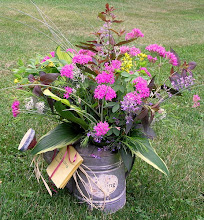 I always have a tough time when people ask me for a plant name. You see, plants have more than one name. They have a true botanical name and many of them have nicknames. Some people only want the nickname, others use the botanical names and some people don't care either way.
I always have a tough time when people ask me for a plant name. You see, plants have more than one name. They have a true botanical name and many of them have nicknames. Some people only want the nickname, others use the botanical names and some people don't care either way.Most of the time I use the botanical name although some plants have such charming nicknames that I can't resist using them. This photo shows Lysimachia clethroides but its nickname is Gooseneck loosestrife. You can easily see why this is its nickname as it looks just like a big gaggle of geese with their heads sticking up.
 Besides their true botanical name, specific plants also have cultivar names. Daylilies are one of the few plants that I break the rule on, their botanical name is Hemerocallis but I just don't want to be bothered calling them that (or typing that over and over again). The true name of this plant would be Hemerocallis 'Raspberry Goosebumps' but I'll just call it a daylily. It happens to be one of the top performers in my garden this year.
Besides their true botanical name, specific plants also have cultivar names. Daylilies are one of the few plants that I break the rule on, their botanical name is Hemerocallis but I just don't want to be bothered calling them that (or typing that over and over again). The true name of this plant would be Hemerocallis 'Raspberry Goosebumps' but I'll just call it a daylily. It happens to be one of the top performers in my garden this year. Echinacea purpurea is nicknamed purple cone flower. I really don't know why it's called that as the cones are orange and in real life, the petals are more a dusty pink than purple.
Echinacea purpurea is nicknamed purple cone flower. I really don't know why it's called that as the cones are orange and in real life, the petals are more a dusty pink than purple. Platycodon grandifloris is another name I rarely use in the garden. The nickname of Balloon flower is easier to say and certainly understandable when you see how the buds blow up like little balloons.
Platycodon grandifloris is another name I rarely use in the garden. The nickname of Balloon flower is easier to say and certainly understandable when you see how the buds blow up like little balloons. Yesterday I saw this unusual bloom on a balloon flower and just had to grab my camera and take it's picture!
Yesterday I saw this unusual bloom on a balloon flower and just had to grab my camera and take it's picture! If you want to be a good gardener, I really recommend that you make the effort to learn the botanical name besides the nickname. When you use nicknames, you can end up with the totally wrong plant. For instance, many people call daylilies "lilies" and yet there's also bulbs that are called lilies. If you are shopping for plants and ask for orange lilies, you could end up with Asiatic lilies which will stay in one spot or the orange roadside daylily which will run all over your garden.
If you want to be a good gardener, I really recommend that you make the effort to learn the botanical name besides the nickname. When you use nicknames, you can end up with the totally wrong plant. For instance, many people call daylilies "lilies" and yet there's also bulbs that are called lilies. If you are shopping for plants and ask for orange lilies, you could end up with Asiatic lilies which will stay in one spot or the orange roadside daylily which will run all over your garden.As for being able to pronounce those names correctly? Don't worry, you don't have to say all those names, just have a good idea of what they are. The spelling doesn't even matter that much, you can always google the name and it will tell you the correct spelling.
Off to see what's in bloom today,
Melanie































